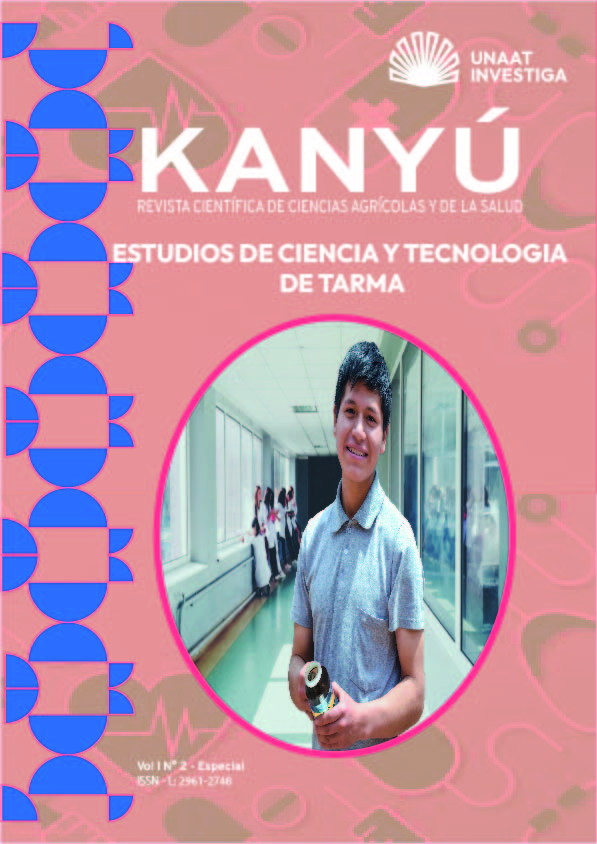Efecto del recubrimiento comestible a base de almidón de cáscara de papa (solanum tuberosa) Huasahuasina – Tarma en la prolongación de la vida útil de la zarzamora (RUBUS ULMIFOLIUS)
Effect of edible coating based on potato peel starch (solanum tuberosa) Huasahuasina - Tarma on prolonging the shelf life of blackberry (RUBUS ULMIFOLIUS)
DOI:
https://doi.org/10.61210/kany.v1i2.Especial.46Palabras clave:
Recubrimiento comestible, Almidón de cáscara de papa, Residuos agroindustriales, BerriesResumen
Los recubrimientos comestibles proporcionan un método potencialmente efectivo para conservar productos alimenticios frescos. El objetivo de la investigación fue prolongar la vida útil de la zarzamora (Rubus ulmifolius) aplicando una capa comestible en base a almidón de cáscara de papa blanca (Solanum tuberosa). Para la formulación de los recubrimientos comestibles se empleó almidón de cáscara de papa como carbohidrato, glicerol como plastificante y cera de abeja como lípido. Para el análisis estadístico de los datos se empleó el Diseño Completamente al Azar (DCA), donde se desarrolló 3 tratamientos; resultando 2 tratamientos con la variación del porcentaje de almidón (0.30 y 0.60 %) y 1 muestra control. Las zarzamoras recubiertas fueron almacenadas en refrigeración a 5°C. Se evaluaron las características fisicoquímicas determinando el (°Brix, % de pérdida de peso, pH, humedad y luminosidad) transcurrido los 8 días de almacenamiento. Los resultados mostraron que la aplicación del recubrimiento comestible ayuda a conservar las propiedades fisicoquímicas de la zarzamora. En cuanto a la muestra 1 (M1), 2 (M2) y 3 (M3 control) se obtuvo como °Brix final (7.4, 6.2, 5.8), pH final (2.43, 2.21, 2.45), peso final en g (50.59, 43.7, 53.29), Humedad % (46.5, 44.92, 47.96); Luminosidad (Lux) (7.36, 8.55, 12.97). La formulación óptima estuvo compuesta por 0,60% de almidón de cáscara de papa blanca, 0,30 % de cera de abeja y 1,22 % de glicerol; siendo mejor en todas las respuestas con respecto a la muestra control. Esta formulación conserva las propiedades organolépticas y nutricionales de la zarzamora.
Citas
Ballesteros-Mártinez, L., Pérez-Cervera, C., & Andrade-Pizarro, R. (2020). Effect of glycerol and sorbitol concentrations on mechanical, optical, and barrier properties of sweet potato starch film. NFS Journal, 20, 1-9. https://doi.org/10.1016/j.nfs.2020.06.002
Brain Wilfer, P., Giridaran, G., Jeya Jeevahan, J., Britto Joseph, G., Senthil Kumar, G., & Thykattuserry, N. J. (2021). Effect of starch type on the film properties of native starch based edible films. Materials Today: Proceedings, 44, 3903-3907. https://doi.org/10.1016/j.matpr.2020.12.1118
Choi, I., Shin, D., Lyu, J. S., Lee, J.-S., Song, H., Chung, M.-N., & Han, J. (2022). Physicochemical properties and solubility of sweet potato starch-based edible films. Food Packaging and Shelf Life, 33, 100867. https://doi.org/10.1016/j.fpsl.2022.100867
Coimbra, P., Alarico, S., Empadinhas, N., Braga, M. E. M., & Gaspar, M. C. (2023). Sustainable starch-based edible films with agrifood residues as potential carriers for the probiotic Lactobacillus rhamnosus. Innovative Food Science & Emerging Technologies, 88, 103452. https://doi.org/10.1016/j.ifset.2023.103452
Coimbra, P., Marona, B., Henriques, M. H. F., Campos, L., Gomes, D. M. G. S., Vitorino, C., Sousa, J. J. S., Braga, M. E. M., & Gaspar, M. C. (2023). Edible films based on potato and quince peels with potential for the preservation of cured cheese. Food Packaging and Shelf Life, 40, 101176. https://doi.org/10.1016/j.fpsl.2023.101176
Ferreira Saraiva, L. E., Naponucena, L. de O. M., da Silva Santos, V., Silva, R. P. D., de Souza, C. O., Evelyn Gomes Lima Souza, I., de Oliveira Mamede, M. E., & Druzian, J. I. (2016). Development and application of edible film of active potato starch to extend mini panettone shelf life. LWT, 73, 311-319. https://doi.org/10.1016/j.lwt.2016.05.047
Ghoshal, G., & Kaur, M. (2023). Optimization of extraction of starch from sweet potato and its application in making edible film. Food Chemistry Advances, 3, 100356. https://doi.org/10.1016/j.focha.2023.100356
Gupta, V., Thakur, R., Barik, M., & Das, A. B. (2023). Effect of high amylose starch-natural deep eutectic solvent based edible coating on quality parameters of strawberry during storage. Journal of Agriculture and Food Research, 11, 100487. https://doi.org/10.1016/j.jafr.2022.100487
Hosseini, P., Hojjatoleslamy, M., & Molavi, H. (2023). Investigation of the mixing ratio of quince seed gum, potato starch and gellan gum on the properties of the resulting film by Mixture Design. International Journal of Biological Macromolecules, 237, 123869. https://doi.org/10.1016/j.ijbiomac.2023.123869
Klang, J. M., Tene, S. T., Nguemguo Kalamo, L. G., Boungo, G. T., Ndomou Houketchang, S. C., Kohole Foffe, H. A., & Womeni, H. M. (2019). Effect of bleaching and variety on the physico-chemical, functional and rheological properties of three new Irish potatoes (Cipira, Pamela and Dosa) flours grown in the locality of Dschang (West region of Cameroon). Heliyon, 5(12), e02982. https://doi.org/10.1016/j.heliyon.2019.e02982
Kowalczyk, D., Kazimierczak, W., Zięba, E., Mężyńska, M., Basiura-Cembala, M., Lisiecki, S., Karaś, M., & Baraniak, B. (2018). Ascorbic acid- and sodium ascorbate-loaded oxidized potato starch films: Comparative evaluation of physicochemical and antioxidant properties. Carbohydrate Polymers, 181, 317-326. https://doi.org/10.1016/j.carbpol.2017.10.063
Kupervaser, M. G., Traffano-Schiffo, M. V., Dellamea, M. L., Flores, S. K., & Sosa, C. A. (2023). Trends in starch-based edible films and coatings enriched with tropical fruits extracts: A review. Food Hydrocolloids for Health, 4, 100138. https://doi.org/10.1016/j.fhfh.2023.100138
Lee, E., Song, H., Choi, I., Lee, J.-S., & Han, J. (2020). Effects of mung bean starch/guar gum-based edible emulsion coatings on the staling and safety of rice cakes. Carbohydrate Polymers, 247, 116696. https://doi.org/10.1016/j.carbpol.2020.116696
Majeed, T., Dar, A. H., Pandey, V. K., Dash, K. K., Srivastava, S., Shams, R., Jeevarathinam, G., Singh, P., Echegaray, N., & Pandiselvam, R. (2023). Role of additives in starch-based edible films and coating: A review with current knowledge. Progress in Organic Coatings, 181, 107597. https://doi.org/10.1016/j.porgcoat.2023.107597
Oyom, W., Xu, H., Liu, Z., Long, H., Li, Y., Zhang, Z., Bi, Y., Tahergorabi, R., & Prusky, D. (2022). Effects of modified sweet potato starch edible coating incorporated with cumin essential oil on storage quality of ‘early crisp’. LWT, 153, 112475. https://doi.org/10.1016/j.lwt.2021.112475
Rahmadi Putri, T., Adhitasari, A., Paramita, V., Endy Yulianto, M., & Dwi Ariyanto, H. (2023). Effect of different starch on the characteristics of edible film as functional packaging in fresh meat or meat products: A review. Materials Today: Proceedings, 87, 192-199. https://doi.org/10.1016/j.matpr.2023.02.396
Schulz, M., Seraglio, S. K. T., Della Betta, F., Nehring, P., Valese, A. C., Daguer, H., Gonzaga, L. V., Costa, A. C. O., & Fett, R. (2019). Blackberry (Rubus ulmifolius Schott): Chemical composition, phenolic compounds and antioxidant capacity in two edible stages. Food Research International, 122, 627-634. https://doi.org/10.1016/j.foodres.2019.01.034
Soto-Muñoz, L., Palou, L., Argente-Sanchis, M., Ramos-López, M. A., & Pérez-Gago, M. B. (2021). Optimization of antifungal edible pregelatinized potato starch-based coating formulations by response surface methodology to extend postharvest life of ‘Orri’ mandarins. Scientia Horticulturae, 288, 110394. https://doi.org/10.1016/j.scienta.2021.110394
Wigati, L. P., Wardana, A. A., Tanaka, F., & Tanaka, F. (2022). Edible film of native jicama starch, agarwood Aetoxylon Bouya essential oil and calcium propionate: Processing, mechanical, thermal properties and structure. International Journal of Biological Macromolecules, 209, 597-607. https://doi.org/10.1016/j.ijbiomac.2022.04.021
Archivos adicionales
Publicado
Cómo citar
Número
Sección
Categorías
Licencia
Derechos de autor 2023 Joselin Paucarchuco Soto , Grimaldo Wilfredo Quispe Santivañez, Kenny Ruben Montalvo Morales, Jimmy Pablo Echevarria Victorio

Esta obra está bajo una licencia internacional Creative Commons Atribución-NoComercial-CompartirIgual 4.0.
Eres libre de:
- Compartir — copiar y redistribuir el material en cualquier medio o formato
- Adaptar : remezclar, transformar y construir sobre el material.
Bajo los siguientes términos:
-
Reconocimiento : debe otorgar el crédito correspondiente, proporcionar un enlace a la licencia e e indicar si se realizaron cambios.
-
No comercial : no puede utilizar el material con fines comerciales.
-
ShareAlike : si remezcla, transforma o construye a partir del material, debe distribuir sus contribuciones bajo la misma licencia que el original.











